
26 minute read
In focus | go west
GO WEST NEW BUS FLEET MANAGEMENT
West Australian bus operator Go West Tours has implemented ‘next generation fleet management technology’ to fine-tune operations, with a successful rollout and adaptation by its drivers, the company reports.
Below:
Drivers have reacted positively to the system, using it to share safety information such as the state of roads
Opposite:
“We found when the platform was successfully adopted it allowed people to explore other capabilities beyond the fundamental functionalities of GPS tracking, speed control and driver fatigue management,” said Go West director David Haoust. A s a key part of its growth strategy, Go West Tours – a WA supplier of charter, rental and tour vehicles, servicing the mining, education, tourism and government sectors as well as private parties – seeks to ensure it continues to offer the latest technology systems to clients to track and manage vehicle speed, driver fatigue, maintenance and safety, it states.
Go West engaged Teletrac Navman to develop a bespoke solution with the broad range of capability it required, it explains.
According to the company, Teletrac Navman’s solution specialists worked closely with Go West to create a tailor-made system, including passenger scanning, fatigue management, geo-fencing, speed management, GPS vehicle tracking and electronic document management.
The custom solution provided comprehensive data harvesting and analysis, so the business could track each trip electronically and improve reporting accuracy, it explains.
“Managing complex change is often challenging and has to be done in a careful manner, but we found the Teletrac Navman platform was really easy to use, which helped us get buy-in from staff,” said Go West Tours director David Haoust.
“We found when the platform was successfully adopted, it allowed people to explore other capabilities beyond the fundamental functionalities of GPS tracking, speed control and driver fatigue management.”
CULTURAL CHANGE
Go West Tours implemented Teletrac Navman’s comprehensive suite of telematics solutions in more than 100 of its buses, equipping 50 of those with the end-to-end telematics solution in two months, it states.
A key part of the solution is an in-vehicle compliance and productivity tool, alongside telematics that provides GPS tracking capabilities, speed management and card reading technology, says Teletrac.
With electronic pre-start capabilities and a new digital process to manage documentation, such as risk assessments, the business streamlined complex compliance requirements while ensuring safety and easy measurability, it explains.
Teletrac Navman understood the sensitivities of the cultural change required to get the drivers on board with the new processes and platforms, it adds. The team hosted a series of ‘onboarding’ sessions for the staff at Go West Tours, so they could quickly and effectively adopt the new technology, it confirms.
This change also had to coincide with the acquisition of 50 new 50-seater buses being rolled out during two months across five different mining sites, the companies state.
Tablet-style data importing, work diary logging and electronic pre-starts were new to bus drivers, but training and the user-friendly nature of Teletrac Navman’s product suite helped Go West achieve the all-important acceptance from drivers while meeting the implementation deadline, it says.

THE UPSHOT
Offering Go West improved control over its business, the technology
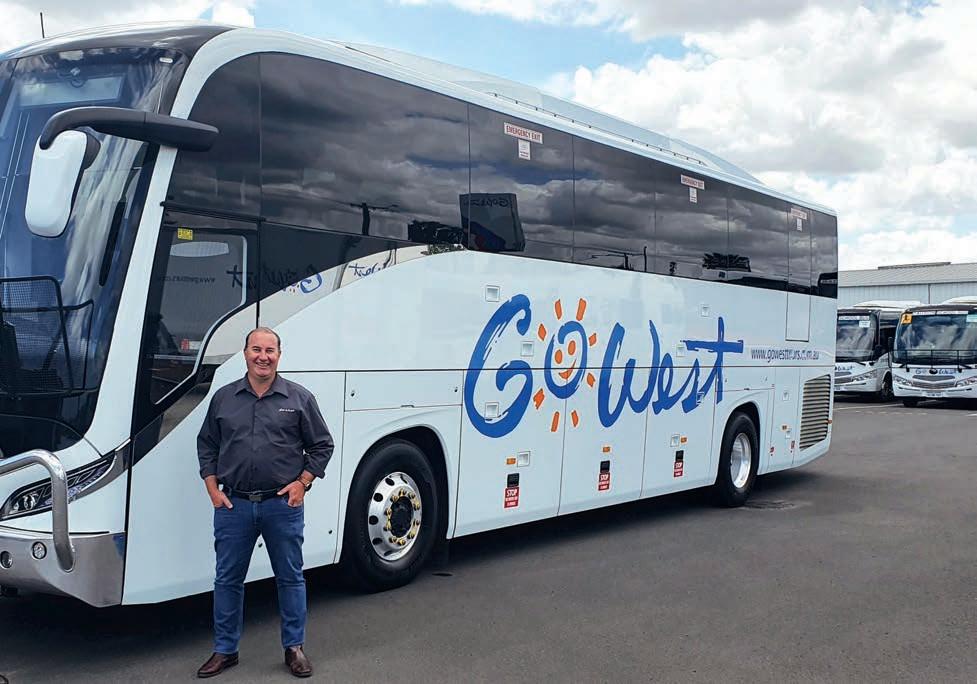
helps senior managers make more informed decisions, promoting greater transparency, it says.
Haoust says the business now has the data to assess and discover better ways of doing things, and an improved sense of what’s going on in the organisation.
The data generated from the platform has generated signifi cant effi ciencies, such as setting up geo-fences around mining sites and using high-defi nition location data to track fuel use on- and off-road for more accurate fuel tax credit calculations, so the business can maximise Australian Tax Offi ce (ATO) claims.
The accuracy of the data and clear reporting around safety and security has enhanced the offering that Go West Tours can make to the biggest mining companies in Australia, it explains.
Simultaneously, the in-cabin systems have empowered drivers to feel more engaged with the business, leading to greater levels of driver performance and work satisfaction, the company explains.
The system provides signifi cant safety benefi ts, such as speed alerts when a vehicle breaches the speed limit, helping drivers to maintain professional and safety standards.
“Drivers love the messaging system and are even using it to share safety information like the state of sections of a road,” said Haoust.
“That’s something they’ve done off their own back, showing what a positive relationship they have with the system.
“When drivers don’t feel like they’re just driving a bus and they have this cutting-edge technology as part of their day to day, it makes them feel more valued and shows that they’re executing a really important job.”
ABOUT GO WEST
Go West Tours is Western Australia’s leading supplier of modern charter, rental and tour vehicles, it says.
It has become one of Australia’s most respected integrated transport providers, employing more than 200 staff across seven agencies in Western Australia, it adds.
Enjoying a reputation for providing safe and reliable transport, the company is the preferred choice for Australia’s blue-chip companies, particularly in the mining space, it says.
It has established strong relationships with resources companies to develop tailored transport solutions that meet clients’ unique needs, it adds.
JUST AROUND THE CORNER
A stream of announcements about the new products that will be on display at this year’s highly anticipated Brisbane Truck Show will be coming over the course of the next few weeks.
With visits to showrooms and customers off the cards for signifi cant parts of the past year, the 2021 Brisbane Truck Show presents the best opportunity to come together and reconnect with customers, peers and the entire industry.
It also allows for these new products, models or innovations to be seen up close.
That applies across the full range of trucks, trailers, components, technology, equipment, accessories and even merchandise.
On the opening morning of the show, highly anticipated new models will be unveiled to an eager audience.
Before the doors open the halls are busy with sales teams putting a fi nal polish on every item and every counter. It is a beautiful thing to see the lights come on, screens light up and the doors open.
But fi rst is the media tour. Each of the truck manufacturers has fi ve minutes for each of their brands; the aim is to get the pack of industry journalists excited about the latest innovations.
Each manufacturer has a different pitch based on its new model: is it packed with safety technology, will it be more productive than existing models, or will we see the spotlight on sustainability in 2021?
Executives from each of the brands are on hand to pull the silks off and tell their stories. Their enthusiasm is infectious.
It is hard not to imagine your own livery painted across cab doors and trailer curtains.
This year will be a little bit different because the crowd will not be packed so tightly as we ensure a COVIDSafe event. But we promise you will be able to get up close to the new models and innovations.
We are lucky enough to be attending the Southern Hemisphere’s largest automotive event, in one of the world’s best convention centres.
That means your experience has been
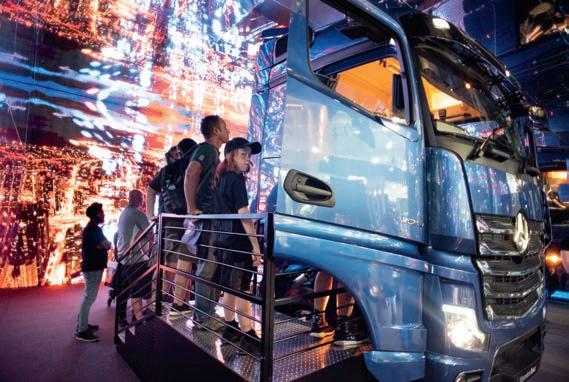
You get great value for a fun day’s entertainment.
carefully planned to ensure your safety and wellbeing are the highest of priorities.
The Brisbane Convention and Exhibition Centre, the Brisbane City Council, the Queensland Government, and the truck show’s organiser Heavy Vehicle Industry Australia are leaving no stone unturned in ensuring a COVIDSafe event.
Likewise, the exhibitors are putting the same degree of care into the planning of their exhibits and following detailed guidelines that have been developed to give everyone confi dence that the rebirth of major Australian business events is delivered successfully by every measure.
Tickets are on sale now. It is hard to imagine better value for a full day’s entertainment and yet this year the show delivers.
Not only is the Brisbane Truck Show accompanied by the South Bank Truck Festival with a huge display of trucks and trailers on display in the parklands, and all the free entertainment in the area, this year your ticket will also get you into the new Civil Construction Field Days – the new heavy equipment and machinery show awash with everything you could ask for in excavators, graders, rollers and the like.
All of that on one ticket!
Then, add to that the chance to win the Ultimate VIP Experience Package just by registering your ticket.
The BTS21 major promotion partner, Morris Finance, has put together a package of amazing experiences including a box at the AFL, V8 supercar hot laps, four Bathurst 1000 corporate suite tickets, and your own racing simulator.
Add to that a large screen TV, SP Tools voucher, bar fridge, BBQ, Walkinshaw Sports golf buggy, a fi re pit, dart board and more.
It’s a heck of a prize and you will be in the running when you purchase and register your ticket to the show.
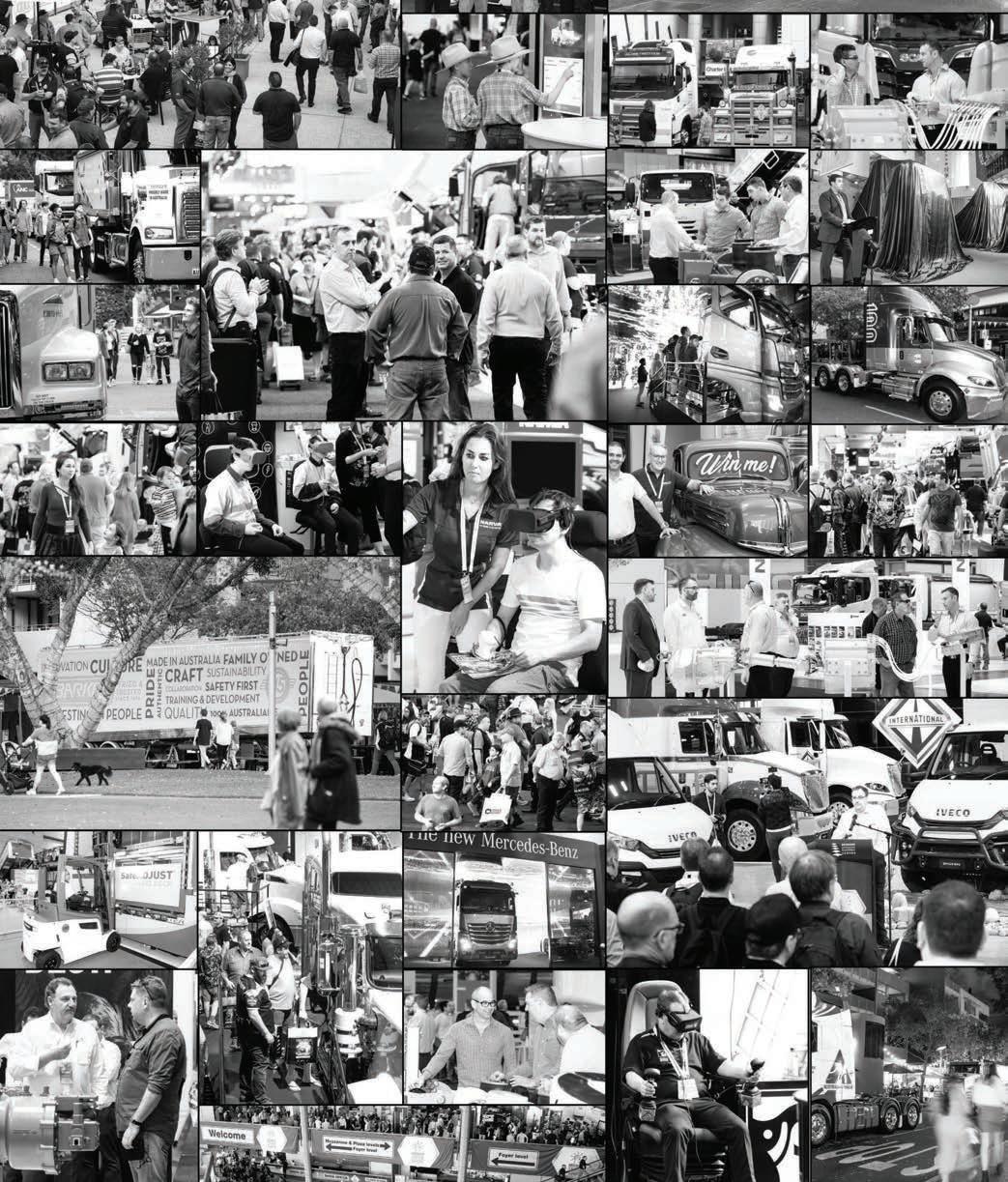


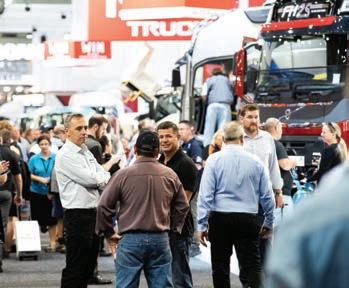
SILVER SERVICE
VOLVO BUS – 50 YEARS IN AUSTRALIA
This year marks 50 years since Volvo Bus first started doing business in Australia. It hasn’t been easy, but through dedication to safety, quality and insightful innovation of bus product – delivered to our invaluable customers through honest and respectful partnerships – we are indeed proud of all we have accomplished today. As always, we will pursue these values into tomorrow and beyond. Please join us as we celebrate our 50th Anniversary here in Australia throughout 2021 and reminisce on the many challenges accepted, the untold goals achieved and, perhaps most importantly, the amazing people we have met and lifetime and generational friendships we have made along the way.
It’s the heat that gets you first. Whether dusty, corrugated Outback tracks or less than perfect city bitumen, Australia’s roads truly test any vehicle that daringly take them on, as almost any automotive manufacturer will attest to.
European driving conditions throughout the years have consistently been remarkably different to what’s here, so when Volvo Europe decided, many years ago, to venture into ‘the great unknown on other side of the world’ with its car, truck and bus products, we quickly realised that there was just no room for error.
We did our research, as we always do. We finessed our products like the B10M and
B58 with quality materials and thoughtful engineering, to meet the local conditions, as we always do. And we brought with us a dedication to passenger comfort and driver safety, fuel efficiency and reliability, as well as an aptitude and attitude to always listen to our customers and learn from our mistakes. As we are happy to admit we do.
Fifty years later, we are proud to say we are still here, doing what we do, and have worked hard to attain and maintain our number one position in the Australian bus market for more than 10 years.
With a changing automotive market around the world - from cleaner diesel engines and hybrid powertrains to full electromobility, market-shaping e-bus tech and ever-evolving battery-charging know-how - Volvo Bus Australia (VBA) is excited at the prospect of continuing this journey with our current and new partners to help provide what we like to think of as the ultimate public transport experience.
Here, we chat to a few Aussie bus industry luminaries whose success gives us great pleasure to be even remotely part of. We absolutely thank them for their valuable time and kind words.
A NEW START
So just how did VBA start? Its inception isn’t as clear cut as many would think, involving the fortunes of Volvo cars globally and decisions on where to export product to – or not – complemented by forwarding-thinking visionaries who through determination and chance meetings saw the bigger picture and potential of a range of Volvo product across the Earth.
The first Volvo cars were imported by Peter Antill and Lance Lowe (who later started his own motor accessories business and motoring news service). In 1962, the concession passed to British and Continental Motors (now Monaco Motors). Annual sales were around 50 units.
Antill devoted his time to the company he started in 1948, Antill Ranger, one of

the trailblazers for heavy interstate transport. He was an ex-Navy Commander and business partner Ken Ranger had been a fighter pilot. Like Lindsay Fox of Linfox, Ken Thomas of TNT and Lou Marks of Brambles, after WW2 they each bought trucks and went into business.
In 1948, a 20-year-old country boy Max Winkless joined Antill Ranger as a driver, but with Antill soon recognising his potential, in 1952 he became NSW manager and then general manger in 1955. It was around this time that Maarten Mooi (eventual Volvo Car and Truck Centre manager in Moorebank, NSW) arrived in Australia and got his first job with Antill Ranger.
Following the interactions of key people, the origins of Volvo buses coming into Australia were unforeseen but now in play.
In 1954, Antill’s truck portfolio expanded to become a dealer for Rootes Commer Knocker trucks, forming a subsidiary called Truck Sales and Service a year later. In 1959, the company became the NSW importer of American-made Mack trucks.
Fate would see transport giant Mayne ‘Nicks’ Nickless purchase Antill Ranger – including Trucks Sales and Service – in 1961, crucially taking Winkless all the way to Sweden. A group led by Winkless and including Antill weren’t thrilled to be part of this new, large organisation and so pooled together and bought TS&S from ‘Mayne Nicks’, setting up shop in Mascot.
This site was soon occupied by Volvo car dealer Svenske Motors, which AB Volvo itself would appoint as importer for NSW, Qld and South Australia in 1965. British and Continental were retained as dealers in Sydney.
Volvo offices subsequently popped in Brisbane, Canberra, Wollongong and Adelaide.
A Winkless trip to AB Volvo in Sweden to discuss importation of cars soon changed topic to trucks once he’d seen Volvo heavy haulers in action. AB’s ‘no’ at first soon changed in the face of his persistence, with two F86 trucks his eventual first stock. These and two others were put into service with Mayne Nickless in late 1966.
This was the start of Volvo’s heavy commercial vehicle base establishment in Australia, with
Above:
Volvo Group Australia opened its new headquarters in Wacol, Brisbane in 2018.

buses inevitably to follow.
In 1968, Volvo AB started to see the brand’s potential in Australia for luxury cars, heavy trucks, buses and earth-moving machines, but local company Swedish Motor Importers lacked the capital to increase volume. After much negotiation, a new company was to be formed and on July 1, 1970, Volvo Australia was announced.
The fi rst managing director was Per Eriksson, from the AB Volvo executive group, who would lead a total of 95 employees in the new company.
Bus became a key product component to the mix and in 1971 a $2 million national headquarters was established for car, truck and bus divisions in Sydney, with VBA delivering its fi rst chassis that year, too.
In years to come, Volvo buses would become the dominant brand in the upgrading of public transport fl eets in Adelaide, Hobart, Melbourne, Canberra and Brisbane.
The rest, as they say, is history...
OUR BUSINESS PARTNERS
PAUL CRAWFORD – MD, CMV Group “My grandfather started CMV in 1934 and his vision was to have a business that was focused on employees, customers and the world in which we live – it was a three-prong approach. He was quite visionary. In 1950, he started staff shareholding and all of that sort of stuff. It was about creating sustainable jobs, serving our customers and building a better society – it was quite altruistic actually.
“My grandfather had an interest in tractors, trucks and buses. We were actually bringing in Diamond T chassis from America and turning them into buses. So that was when we started with buses.
“Throughout that period we converted quite a few trucks into buses. In the ‘70s we came on board with Volvo bus and we got Volvo trucks in 1968. These were B58s and B57s and we went from there and we sold quite a few buses across Australia.
“We sold an odd 300 to the local authority, which were B59s with rear engines. In fact, we still have one which we’ve kept for history. It’s kept at the dealership. We bought it off the PTA. I forget how old it was when we bought it, but despite the many miles it has done – it still runs.”
BERNARD ROYLE - previous owner Forest Coachlines “We bought our fi rst Volvo in about 1970, which was a B57, and this was I believe the fi rst Volvo route bus in Australia. When this vehicle had fi nished its life we gave it to the Bus Museum in Sydney, where I believe it comes out on certain days. It was registered m/o5996.
“Our next lot of Volvos were six B58s, which were bought from Grendas, brought up to Sydney and had Custom Coaches bodies fi tted to them. They were heavy-duty vehicles and became the front line vehicles of the fl eet. With their stronger motors they were able to handle the heavy loads up Roseville Hill, as at that time our patronage
VOLVO TIMELINE
1927
Volvo the company is born - fi rst Volvo car rolls off the production line 1928
The fi rst Volvo bus is built on a truck chassis 1934
The fi rst specialised Volvo bus chassis is built
The fi rst Volvo bus powered by raw vegetable oil 1945
Volvo’s diesel engine is installed for the fi rst time in a bus chassis
The fi rst Volvo bus with more effi cient diesel engine 1951
The mid-engine concept is used for the fi rst time in the Volvo product range 1955
The world’s fi rst turbo-charged diesel featuring lowered fuel consumption 1965
Volvo Bus introduces the Volvo B58, the fi rst chassis sold in a large quantity
1979
Volvo Bus introduces the Volvo B10M, the highest selling bus worldwide for citybuses, inter-city and coaches 1981
Volvo Buses makes more than 4,000 buses for the fi rst time in one year. Volvo takes over Säffl e Karossfabrik AB
B6 is introduced in Australia 1984
The fi rst Volvo engine with intercooler is produced 1995
Environmental Concept Bus (ECB) 1988
The fi rst Volvo bus chassis (Volvo wC) is built in Australia, designed specifi cally for the Australian market 1991
Volvo Bus introduces a rear-engine chassis, the Volvo B12 & Volvo B10B 1992
VBC delivers the fi rst gas-powered buses
VBC delivers the fi rst bi-articulated bus 2000 - B7L is introduced in AUS
2002

Volvo introduces the fuel-saving gearbox I-Shift, the fi rst of its kind 2003

The world’s fi rst Euro V bus, featuring SCR technology
B12B and B12BLE are introduced in AUS 2005
The Volvo B12BLEA articulated bus is launched in Australia
Volvo’s fi rst bi-articulated bus with low fl oor, optimised for BRT 2006
Volvo Bus introduces Euro IV compliant engines, dramatically cutting emissions and fuel consumption 2007
The Volvo B9R is launched in Australia, being the fi rst bus powered by 100 per cent biodiesel
Volvo becomes the world’s leading provider of Euro V buses 2008
Volvo launched the Volvo 7700 Hybrid bus and the Volvo B5L Hybrid double decker bus in Europe
was growing at a fast rate. Over the following years we added to the fleet with B58 and B10M vehicles.
“Service was excellent over the years and if a part was needed to keep a vehicle on the road everything was done to get it to us – even if it had to come from Sweden. The two people I remember most were Simon Bath and Ray Andrich as they were our main line of contact.
“I have many fond memories of Volvo. The tours of the factories were probably the most helpful part to be able to see how what we were buying was put together.
“I think the early B58s stand out in my memory, which worked all day every day. With the heavy carrying capacity it enabled us to handle the growing business more efficiently.”
CHRIS FOGG – MD Port Stephens Coaches “PS Coaches is a third-generation company. My family have been in the industry for 90 years. My family started in running people back and forth from Cessnock and Morelands, even before PS was formed.

Above:
The Volvo bus product was great at handling tough Aussie conditions.
Right:
The Perth PTA is a key customer for VBA.
Opposite:
Port Stephens coaches has 100 vehicles in the fleet, around 80 per cent being Volvos.
“The family moved from the coal fields and ventured into Newcastle where my grandfather Syd developed some businesses and bought into Port Stephens buses back in 1957.
“His brother was in the [bus] industry and Syd had three brothers who I believe were all involved in the industry. It was his oldest brother that got started with it and then they all followed.
“PS Coaches was a very small business that was operating buses back and forwards from the Tomaree peninsula, Nelson Bay area and Newcastle with workers. It was around 1962 that my father moved to Port Stephens with my mum and they managed a business and that’s when they started to develop PS Coaches. The business had a lot of growth in the late ‘60s, ‘70s and ‘80s. It grew incredibly fast and mum and dad were able to grow with the business in that time along with raising a young family.
“Between the PS Coaches and Newcastle coaches we have expanded and we have over 100 vehicles. In the PS and Newcastle fleet it would be 80 per cent Volvo. My dad purchased his first Volvo for PS Coaches in 1981.
“For drivers it has been a refined

1967
Volvo Bus produces its first articulated bus (lower fuel consumption per passenger)
1994
Volvo Bus launches the Volvo B10L lowfloor chassis
2009
The environmentally friendly Euro 5 and EEV compliant engines are introduced 1968
Volvo Bus becomes an independent division within the Volvo Group
1995
The Volvo B12 receives the Coach of the Year award
1971
B57 is introduced in Australia Volvo Bus comes to Australia 1st B58 Volvo Bus is delivered in November - Grenda Bruce Tilley’s – the first Volvo, a B58-50 with Denning body new Sep 71. It was semi auto 1st B59 city bus with a low floor, is launched
1996
The first biogas bus 1997
The first gas turbine hybrid bus in field test 1972
The Volvo Group declares Environmental Care to be added as one of its Core Values – joining Safety and Quality
Forest 5996 SBM 1975
Volvo Bus wins its first large Govt. contract in Australia - Brisbane City Council order 98 Volvo B59 buses 1976
Volvo Bus sells the first articulated bus in Australia
1998
The first version of the Volvo B7R and B7RLE is launched in Australia 2000
Globally, Volvo Bus delivers more than 11,000 buses for the first time in a single year B7L introduced in Aust The first Volvo bus with particulate filter in series production 2001
Volvo Bus presents the TX chassis platform
2010
The Volvo B13R is launched in Australia
Volvo Bus delivers more than 600 buses in a single year in Australia
Volvo buses starts the serial production of Volvo 7700 Hybrid buses, with up to 35 per cent lower fuel consumption 2011
Production begins on Volvo B11R chassis 2015
B8R and B8RLE are introduced in Australia 2017
B5L is introduced in Australia 2021
B8L DD and B0E will be introduced in Australia
product to drive and it is a product that we purchase because of the quality and the great relationship we have with the company.
“They’ve all been good vehicles. The B10M has probably been the backbone of the industry for a lot of operators in the industry. The B12 was also sensational and is still unsurpassed in terms of reliability and being a really good vehicle. The B7s B8s and B9s were also fantastic. Throughout the past 15–20 years we’ve seen a lot of really good products.”
KEN GRENDA – founder Grenda Corporation “The association with Volvo has been good for us. They have always been the best people to deal with.
“In 1967, Ken and a few other operators did a round-the-world trip to visit every major manufacturer of buses. At the time, the brands of the day like Bedford and Leyland were not meeting the needs of the Australian market, so they were looking for something better. Having trialled a few brands, Ken and the team settled on Volvo and in 1971 Grenda was appointed as the Volvo Bus chassis seller. The progress wasn’t without issue [however], with the government promoting Australian-made and putting a few obstacles in the way.
“Over time, Grenda and Volvo separated. The body-building rights were acquired by Volgren and in Victoria, CMV, led by Jim Crawford, became the agent for Volvo Bus in Victoria. It was a time characterised by family businesses and strong family values – something shared by the Grenda and Crawford families, now over many decades.”
NEIL ROBINS – secretary, Tasmanian Bus and Coach Society “We embark on scenic and enthralling tours across Tasmania and are committed to the care and restoration of historical buses and coaches. Our tours cover anywhere from anywhere from 30km to over 600km and we like to think of ourselves as Australia’s only ‘living museum’ as we showcase vintage vehicles to the public across Tasmania. We have 11 vehicles within the fl eet at the moment.
“Ninety per cent are in club registration, which is valid for 30 years, which allows us to take them all around Tasmania and take them to the car and truck shows. Everything nowadays is automatic and it’s nice to step back into the past with these older vehicles.
“The fi rst Volvo I drove was the B58 artic that I own; however, since establishing the society, the Bluebird was certainly the pick (defi nitely the most luxurious). Yet, the latest 1988 B10M with Hyliner body is exceptional to drive with the 12-speed splitter, so driver-wise the Hyliner is the pick for me.”

Above:
David Mead, vice president of Volvo Bus, Asia Pacifi c.
Below:
2021 is a year of celebration for Volvo, marking 50 years since the brand began operating in Australia .
OUR PEOPLE
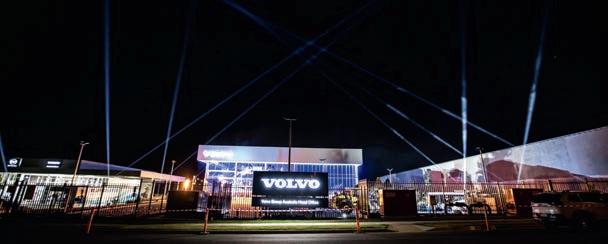
DAVID MEAD – vice president Volvo Bus, Asia Pacifi c “Milestones? 2010 stands out as one where Volvo Bus Australia had over 600 units delivered, taking us to number one that year, which was a turning point. Now, to have more than a decade of leadership has been amazing. It’s hard to get there and harder to stay there. So I’d say that in 2010 it was a breakout year. From then it’s been an achievement to maintain that.
“What has contributed to our success has been never taking business for granted! We work hard not to be complacent. People often ask who are the key customers – but to me it doesn’t matter, they’re all key. You can be part of the Volvo family buying one or 100 units. We’ve also been humble in our position of leadership. For many customers that is very comforting. They’ve made that decision to work with us. It means they’ve trusted us to be their business partner more than any other brand.
“What will set VBA apart from its competitors in years to come is continuing to innovate in products – be it electric or other fuels. The other thing is that the organisation needs to keep evolving as each city changes the way they do transport. As the market changes, we must change.”
BUS STOP KING LONG IS SIMPLY BETTER VALUE
FULLY SUPPORTED


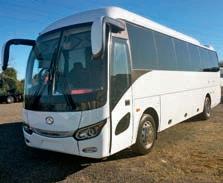
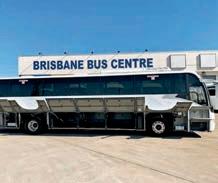
NEW KING LONG 35-39 SEATER
Cummins UK 6.7L ISBe 250HP, ZF 6 speed automatic, Independent front suspension, 39 fixed high back cloth seats with seatbelts.

$POA Perfect School Bus
NEW KING LONG 12M 53-57 SEATER
$POA In Stock Now
NEW KING LONG 41-45 SEATER
Cummins UK 6.7L ISBe 285HP, ZF 6sp automatic, independent front suspension, 41 reclining high back leather seats with seatbelts.
$POA Perfect Tour Bus
NEW KING LONG 13M 57-61 SEATER
$POA Class Leading Ride


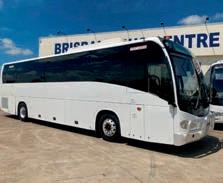
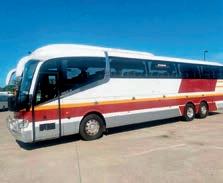
NEW ISUZU I-BUS 2632 SEATER MINIBUS
Isuzu turbo diesel, AMT transmission, 26-32 fixed seats with seatbelts, front engine bus.
$POA Perfect School Bus
2016 YUTONG ZK6938H 39 SEATER COACH
Cummins 6.7 litre ISB 6 cylinder engine, Allison automatic, 39 fixed cloth seats with seatbelts, bullbar, towbar, low klms.
Value at $140,000 + GST
2013 IVECO/KING LONG 53 & 57’S
Both 53 and 57 belted available,TK Air, good bins, Cummins, Allison, Auto, Bright’s bar, recent repaint, ready for work in 2021.
Value at $115,000 + GST
2014 IVECO IRIZAR 13.5M COACH
What a coach! 52 belted/ reclining, toilet, DVD/TV screens, Alloys, Steerable lazy, big bins, ready to go!
Priced at $219,000 + GST









